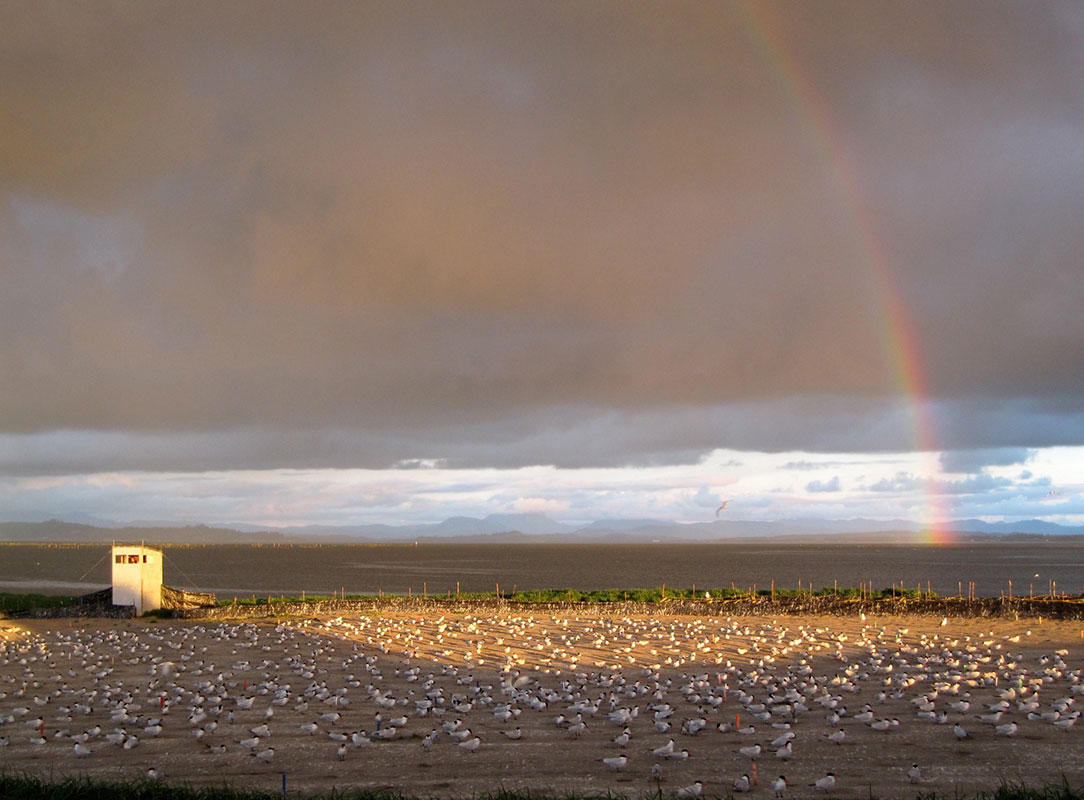 Tern Management on East Sand Island, 2018
Tern Management on East Sand Island, 2018
The primary objective of this study in 2018 was to monitor and evaluate management implemented by resource management agencies to reduce the number of Caspian terns (Hydroprogne caspia) nesting on East Sand Island in the Columbia River estuary. The goal of these management actions is to reduce tern predation rates on ESA-listed juvenile salmonids (Oncorhynchus spp.) in the estuary. First, with guidance from the responsible resource management agencies, we delineated and prepared 1.0 acres of bare ground habitat for terns to nest on at East Sand Island. Then we attempted to prevent nesting by terns on East Sand Island outside that designated 1.0-acre nesting area, while monitoring for potential effects of tern management actions on other colonial waterbirds that nest and roost on the island. We also monitored tern nesting activity on East Sand Island throughout the tern nesting season and assessed tern diet composition and factors that limited tern colony size and nesting success. Lastly, we monitored inter-colony movements and dispersal patterns of Caspian terns from East Sand Island to evaluate the efficacy of management implemented to disperse nesting Caspian terns to alternative colony sites outside the Columbia River basin.
The management plan “Caspian Tern Management to Reduce Predation of Juvenile Salmonids in the Columbia River Estuary” was first implemented in 2008, and implementation continued during the 2018 nesting season. The objective of this management plan is to reduce the size of the Caspian tern breeding colony on East Sand Island to 3,125-4,375 breeding pairs by reducing habitat to 1.0 acres of suitable nesting habitat at East Sand Island, while preventing Caspian terns from colonizing other sites in the Columbia River estuary. As part of this plan, we delineated 1.0 acres of lightly vegetated habitat and, using disking and rototilling, created 1.0 acres of bare-ground nesting habitat for Caspian terns on East Sand Island prior to the 2018 nesting season; the same surface area of nesting habitat was provided for terns during the 2015-2017 nesting seasons. One acre of nesting habitat is 20% of the area of habitat prepared for terns on East Sand Island prior to the implementation of the management plan in 2008.
Caspian terns arrived on the East Sand Island colony and initiated nesting late in 2018 compared to previous years. The tern colony slowly grew to a peak size (number of breeding pairs) in mid-June, when about 4,959 breeding pairs (95% c.i. = 4,682 – 5,236 breeding pairs) were estimated to be nesting at the East Sand Island colony. The number of breeding pairs on the colony then slowly declined until the colony area was vacated for the season in early September. The 2018 colony size estimate is significantly larger than the 2017 estimate of peak colony size on the 1.0-acre colony area (3,500 breeding pairs), and 13-59% greater than the management objective of 3,125-4,375 breeding pairs for the tern colony on East Sand Island. At peak colony size, tern nesting density on the 1.0-acre designated colony area averaged 1.23 nests/m2 (95% c.i. = 1.16 – 1.29 nests/m2), significantly greater than average nesting density in 2017 (0.97 nests/m2), but significantly lower than the average nesting density in 2016 (1.36 nests/m2). Although productivity (average number of fledglings raised/nesting pair) was much lower than the long-term average, some Caspian tern young were raised at the East Sand Island colony in 2018 despite high Columbia River discharge, which negatively affects forage fish availability, and frequent disturbance of the tern colony by bald eagles (Haliaeetus leucocephalus) early in the breeding season.
Before and during the 2018 nesting season, we installed a total of 3.81 acres of passive tern nest dissuasion materials (posts, rope, and flagging) in a successful effort to limit tern nesting on East Sand Island to just the 1.0 acres of designated tern nesting habitat. Any Caspian terns that attempted to nest on the eastern half of East Sand Island outside the 1.0-acre designated colony site were actively hazed by members of our field crew to further discourage nesting. This was the fourth breeding season that we were tasked with Caspian tern nest dissuasion activities as part of BPA-funded monitoring and evaluation on East Sand Island, and the second year that those efforts were effective in preventing any Caspian terns from successfully nesting outside the 1.0-acre designated colony area. In 2015 and 2016, satellite tern colonies became established, at least briefly, outside the designated 1.0-acre colony area; those satellite colonies supported a total of 810 breeding pairs and 700 breeding pairs in 2015 and 2016, respectively.
The average proportion of juvenile salmonids in the diet of Caspian terns nesting on East Sand Island during the 2018 nesting season was 40% (percent of identified prey items), somewhat higher than the salmonid proportion in 2017 (36%), and more similar to the proportion in 2015 (38%; no diet composition data were collected in 2016). During all three of these years, the average proportion of juvenile salmonids in the diet of terns nesting at East Sand Island has been higher than the long-term average (31%) measured during the 2000-2014 breeding seasons. As in previous years, estuarine and marine forage fishes (e.g., anchovy [Engraulidae], surf perch [Embiotocidae], smelt [Osmeridae], and herring [Clupeidae]) were collectively most prevalent in the tern diet, together averaging 50% of all identified bill-loads in the diet of terns nesting on East Sand Island in 2018. Although the proportion of anchovy in the diet of Caspian terns nesting at East Sand Island was well below the long-term average, herring represented a much greater proportion of the tern diet in 2018 compared to the long-term average. Bioenergetics calculations to estimate total smolt consumption by Caspian terns nesting at East Sand Island in 2018 are currently in progress and will be included in a subsequent version of this annual report. Predation rates on specific populations of anadromous salmonids (ESUs/DPSs) by Caspian terns nesting on East Sand Island in 2018 were investigated by recovering smolt PIT tags from the surface of the tern colony after the breeding season. That study was funded separately by the U.S. Army Corps of Engineers – Portland District, and study results will be presented as part of a separate report to that funding agency.
Resightings of previously-banded Caspian terns on East Sand Island during the 2018 nesting season indicated that there is strong natal and breeding philopatry to the East Sand Island colony, and some terns are immigrating to the East Sand Island colony from other colonies throughout the Pacific Flyway, especially the two managed colony sites in the Columbia Plateau region: Goose Island and Crescent Island. Resightings of banded terns in 2018 that were seen on East Sand Island during the 2017 breeding season indicate that some adults are dispersing from the East Sand Island colony to alternative colony sites in the Columbia Plateau region. There was no effort to resight banded terns at other colony locations in the Pacific Flyway outside the Columbia River basin in 2018, however, so the level of connectivity between the East Sand Island colony and other colonies throughout the region during the 2018 breeding season is unknown.
- Bird Research Northwest
Click here to see full report



